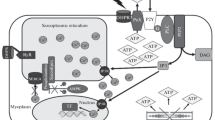Abstract
Several factors have an influence on the improvement of muscle activity and motor co-ordination of mammals during post-natal development. One of them is voltage sensitive L-type calcium channel function. In striated muscles of adult mammals these channels are located in T-tubule membranes thus linking the on-coming action potential to the molecular process of muscle contraction. The postnatal development of L-type calcium channels is therefore critical not only for contraction but also for all subsequent motor learning. We used high affinity enantiomer of dihydropyridine labelled with a fluorophore in order to show the relative amount of L-type calcium channels by histofluorescence in tissue. We found by qualitative microscopical analysis that the amount of L-type calcium channels increased during the postnatal development in the mouse skeletal muscle (m. rectus femoris and m. gastrocnemius). We also noted variation between different fibre types in the increase of the amount of L-type calcium channels, as judged by the intensity of histofluorescence. We showed by histochemical staining and statistical analysis that the high density of L-type calcium channels in adult muscles is correlated with fast oxidative glycolytic fibre type of striated muscles rather than slow oxidative or fast glycolytic fibres. Based on this finding we propose that the development of L-type calcium channels can be considered as one of the factors determining the different physiological properties of fibre types.
Similar content being viewed by others
References
Bean P (1989) Classes of calcium channels in vertebrate cells. Annu Rev Physiol 51: 367-384.
Brooke MH and Kaiser KK (1970) Three ‘myosin-adenosine triphosphatase’ systems: the nature of their pH lability and sulfhydryl dependence. J Histochem Cytochem 18: 670-672.
Catterall W (1993) Structure and modulation of Na+-and Ca2+-channels. Ann NY Acad Sci 707: 1-19.
Flucher BE (1992) Structural analysis of muscle development: transverse tubules, sarcoplasmic reticulum, and the triad. Dev Biol 154: 245-260.
Fosset M, Jaimovich E, Delpont E and Lazdunski M (1983) [3H]Nitrendipine receptors in skeletal muscle: properties and preferential localization in transverse tubules. J Biol Chem 258: 6086-6092.
Franzini-Armstrong C (1991) Simultaneous maturation of transverse tubules and sarcoplasmic reticulum during muscle differentiation in the mouse. Dev Biol 146: 353-363.
Goldspink G (1977) Design of muscles in relation to locomotion. In: Alexander R and Goldspink G (eds) Mechanics and energetics of animal locomotion. (pp. 1-22) Chapman and Hall, London.
Gonoi T (1993) Patch-clamp study of developmental changes in voltage-dependent ion channels of mouse skeletal muscle fibres. Ann NY Acad Sci 707: 352-355.
Grabner M, Friedrich K, Knaus H-G, Striessnig J, Scheffauer F, Staudinger R, Koch W, Schwartz A and Glossmann H (1991) Calcium channels from Cyprinus carpio skeletal muscle. Proc Natl Acad Sci 88: 727-731.
Gutierrez LM, Brawley RM and Hosey MM (1991) Dihydropyridine-sensitive calcium channels from skeletal muscle. Proc Natl Acad Sci 88: 727-731.
Järvilehto M and Rissanen S (1987) The conduction velocity in the mouse skeletal muscle studied at a range of temperatures and with different developmental ages. J Physiol 390: 248p.
Knaus H-G, Moshammer T, Friedrich K, Kang HC, Haugland RP and Glossmann H (1992) In vivo labelling of L-type Ca2+ channels by fluorescent dihydropyridines: evidence for a functional, extra-cellular heparin-binding site. Proc Natl Acad Sci 89: 3586-3590.
Ma J, Gonzàles A and Chen R (1996) Fast activation of dihydropyridine-sensitive calcium channels of skeletal muscle. J Gen Physiol 108: 221-232.
Nachlas MM, Tsou K, De Saiza E, Cheng C and Seligman A (1957) Cytochemical demonstration of succinic dehydrogenase by the use of new p-nitrophenyle substituted ditetrazole. J Histochem Cytochem 3: 170-195.
Romey G, Garcia L, Dimitriadou V, Pincon-Raymond M, Rieger F and Lazdunski M (1989) Ontogenesis and localization of Ca2+ channels in mammalian skeletal muscle in culture and role in excitation-contraction coupling. Proc Natl Acad Sci USA 86: 2933-2937.
Schneider MF and Chandler WK (1973) Voltage dependent charge movement in skeletal muscle: a possible step in excitation-contraction coupling. Nature 242: 244-247.
Singer D, Biel M, Lotan I, Flockerzi V, Hofmann F and Dascal N (1991) The roles of the subunits in the function of the calcium channel. Science 253: 1553-1557.
Spector I and Prives JM (1977) Development of electrophysiological and biochemical membrane properties during differentiation of embryonic skeletal muscle calcium channels. Br J Pharmacol 108: 884-891.
Tanabe T, Beam KG, Powell JA and Numa S (1988) Restoration of excitation-contraction coupling and slow calcium current in dysgenic muscle by dihydropyridine receptor complementary DNA. Nature 336: 134-139.
Umezu Y, Hachisuka K, Ueda H, Yoshizuka M, Ogata H and Fujimoto S (1992) Histochemical and immunological analyses of differentiating skeletal muscle fibers of the postnatal rat. Acta Anat 143: 1-6.
Yuan S, Arnold W and Jorgensen AO (1991) Biogenesis of transverse tubules and triads: immunolocalization of the 1,4-dihydropyridine receptor, TS28, and ryanodine receptor in rabbit skeletal muscle develo** in situ. J Cell Biol 112: 289-301.
Author information
Authors and Affiliations
Rights and permissions
About this article
Cite this article
Mänttäri, S., Pyörnilä, A., Harjula, R. et al. Expression of L-type calcium channels associated with postnatal development of skeletal muscle function in mouse. J Muscle Res Cell Motil 22, 61–67 (2001). https://doi.org/10.1023/A:1010305421661
Issue Date:
DOI: https://doi.org/10.1023/A:1010305421661




